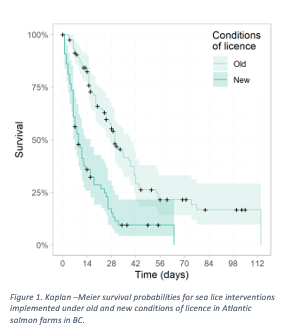ASSESSING THE EFFECTS OF IMPLEMENTING NEW REGULATIONS OVER SEA LICE MANAGEMENT AND CONTROL IN ATLANTIC SALMON FARMS IN BRITISH COLUMBIA, CANADA
Farmed Atlantic salmon are frequently infected with sea lice (Lepeophtheirus salmonis), which can increase the exposure of wild out-migrating salmon to this parasite. To minimise this, in 2020, Fisheries and Oceans Canada introduced several changes to marine finfish licences.
Our objectives were to describe current and past sea lice management and control practices and to assess the effects of the 2020 changes to conditions of licence.
Datasets with mitigation events and industry-reported sea lice counts were used to determine sea lice abundance for each event from two weeks before the intervention to eight weeks after. Exploratory data analysis was used to describe changes in sea lice abundance over this 11-week period while a Cox proportional hazards model was used to compare how long it took to reduce sea lice abundance below regulatory thresholds.
ur analysis suggests that when an intervention was implemented, the abundance of sea lice was reduced. However, the rate and duration of this reduction depended on the type of mitigation used. Additionally, we determined that abundance at the start of in-feed medication was associated with the time needed to reduce sea lice under threshold. Compared to previous years, interventions after the introduction of new regulation favor the use of mechanical and bath treatments and are initiated at lower abundance. Using our cox model, we found that the time needed to reduce sea lice has also reduced significantly. While in previous years about 50% of the mitigation events managed to reduce lice below threshold in the first month, almost 90% of the interventions currently achieve that objective.
In conclusion, as farmers have incorporated new mitigation alternatives in response to challenges such as the appearance of resistance to emamectin benzoate and the implementation of new regulation, we have observed their ability to manage and control sea lice infestations has improved. Although these changes cannot be attributed to regulation alone, our findings suggest availability of multiple therapeutical tools and active management of sea lice to mandatory thresholds have played an important role in the farmer’s ability to control sea lice.
